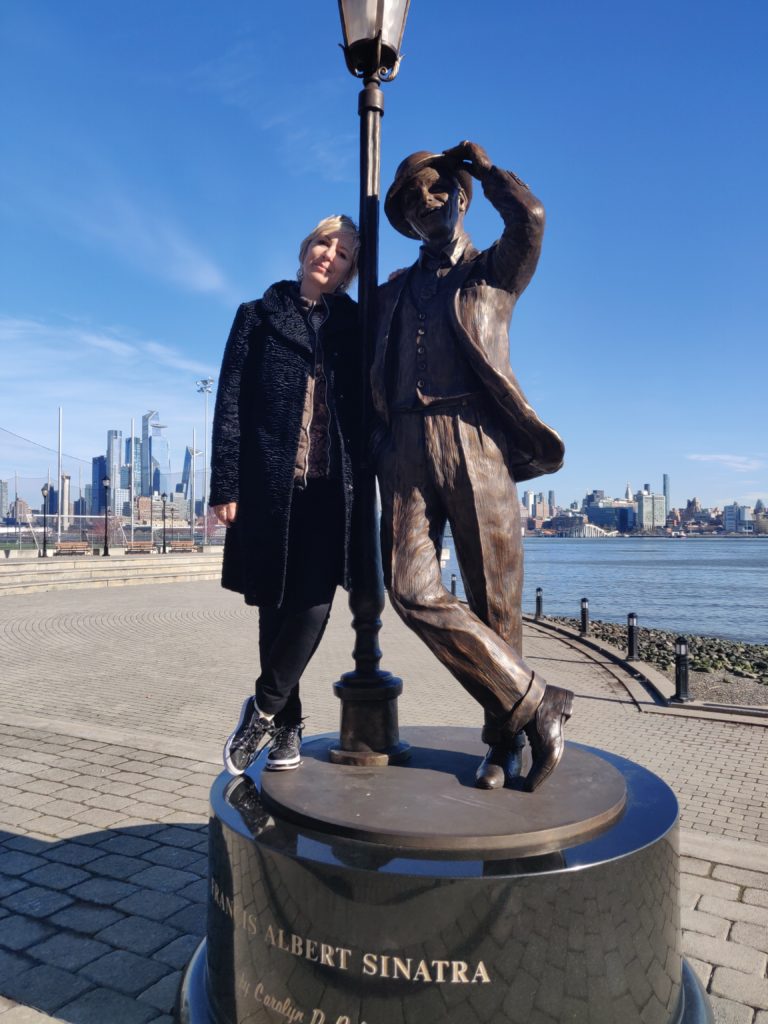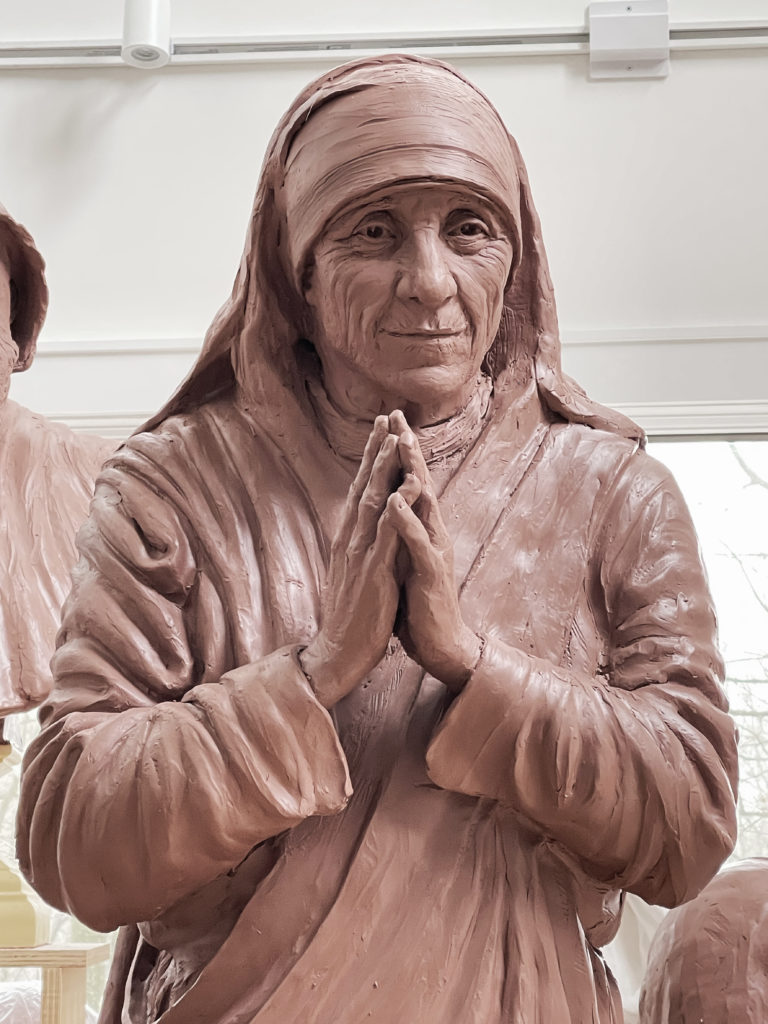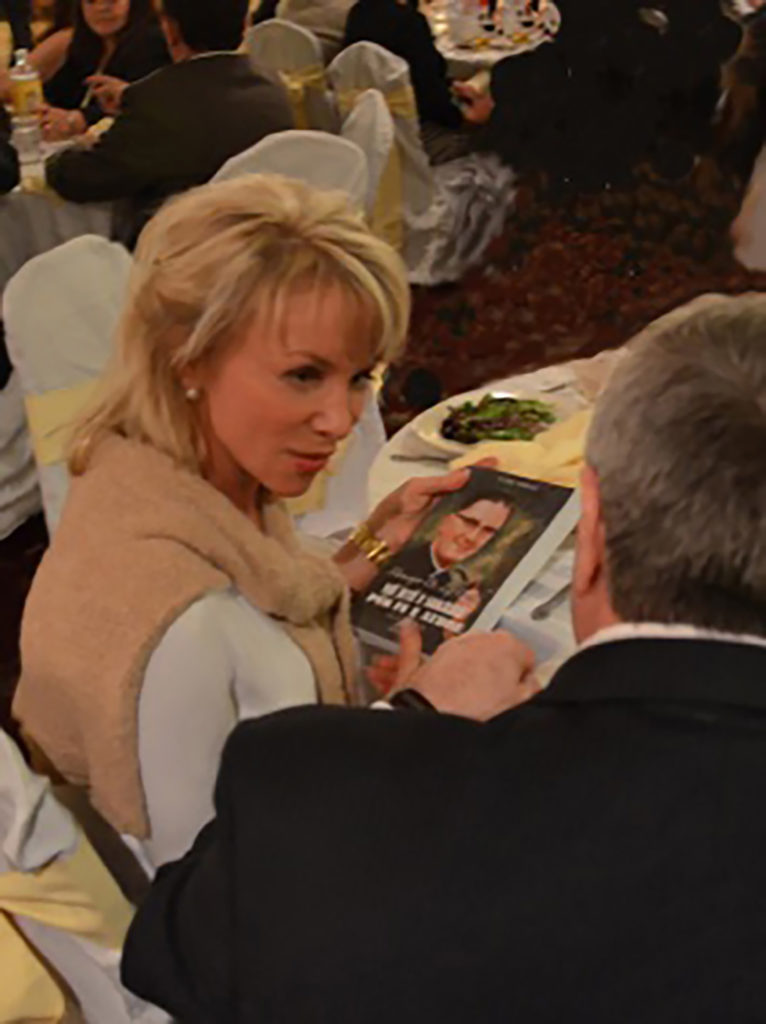



Rafaela Prifti/
Sculptor Carolyn D. Palmer is a world famous artist who you might have even encountered or have taken a picture with at a San Orlando Airport lobby, or at the New York Historical Society Museum, the FDR Presidential Library, St. Patrick’s Cathedral, “Our Lady of Shkodra” in New York, or perhaps at a public venue. She sculpts life-size statues and busts of bronze, marble, clay and wood with true passion and devotion for every detail that goes into capturing the essence of people sculpted into her artistic vision. So, after knowing Carolyn Palmer through her sculpting and her creations, Dielli was granted exclusive access for a one-on-one interview with the artist.
The New York native attended John S. Burke Catholic High School in Goshen and went on to graduate cum laude from Nazareth College in Rochester, New York. Her primary interest was to be a student of sciences as she, at first, considered going into the field of medicine, where she could see herself doing medical illustrations. Palmer eventually answered her true calling and studied art privately throughout Europe and the United States. A larger-than-life statue of Thomas Jefferson – the first sculpture she made, was completed in 2003. It is displayed at the Jefferson Building at Syracuse while Palmer’s own copy stands outside her front door.
– You are an internationally acclaimed sculptor whose bronze statues of larger-than-life figures have touched the lives of people at every corner of the world. Rather than communicating through the sculptures, what do you say to the audience about yourself. Can you take us back to the beginning?
As a child I began sculpting for fun in the sandbox. I was always intrigued with sculpting faces and figures and also enjoyed drawing portraits of my friends. Later, I became a portrait painter and was asked to paint a life size portrait of a businessman’s son. The man owned a building in Syracuse NY called, The Jefferson Center” He asked if I knew anyone who could sculpt a life size bronze Thomas Jefferson. I was overly excited about creating the sculpture myself and asked him to please give me the opportunity. That was my first sculpture and others liked it so much that I was asked to sculpt more figures.
– Going from your first to the most recent sculpture that took a year to complete – a life-sized bronze statue of Frank Sinatra was unveiled last December in Hoboken to mark Ol’ Blue Eyes’ 106th birthday. He is leaning against a lamp post smiling and tipping his hat. You even made the lamp post hollow so it could be wired with an operational light for nighttime. When asked about the statue you refer to a personal inspiration with it. Would you say that is a typical process for you?
Yes, I always begin by researching photos, movies, etc. I look through as many images as possible and pick ones that emphasize the person’s most recognized personality. Then I enlarge them to life-size photos in my studio. For Frank Sinatra, I played his music and movies non-stop to where his spirit permeated my studio.
– According to news reports, the Hoboken officials approached you after seeing the cover of Catholic Magazine. It was a picture taken in your studio in Saddle River where you are standing with bronze busts of four popes. Can you tell us more?
On March 3, 2019, Hoboken’s Business Administrator e-mailed me after seeing my four papal busts on the front of the Catholic Magazine. He stated how overly impressed he was with their likenesses and asked if I would accept a commission to sculpt Frank Sinatra. I was so excited but it actually took a year to secure the contract.
– You created four life-size bronze busts for the entrance vestibules to St. Patrick’s Cathedral in New York City in honor of the pontiffs who have visited the Cathedral: Pope Francis, Pope Benedict XVI, Pope John Paul II and Pope Paul VI. They were permanently installed on marble shelving in 2018 and each day they greet hundreds of visitors going into the Cathedral from the Fifth Avenue entrance. What kind of pressure does that put on you?
I always feel pressure creating any beloved figure because people become emotionally attached to them. My inspiration to sculpt comes from a desire to bring joy or an emotional connection with the viewer. Even though I felt a lot of pressure to get their likenesses, they were exciting to sculpt because they had various facial characteristics from four different countries: Argentina, Poland, Italy and Germany.
– Your bronze busts of the Wright Brothers were acquired by the Sanford, Orlando airport, for its lobby. You were commissioned to create bronze busts of Franklin and Eleanor Roosevelt for the entrance foyer of the FDR Presidential Library and Museum in Hyde Park. You say that the Lucille Ball sculpture was particularly stressful.
There was a lot of pressure in creating Lucille Ball because I was given a pressing deadline and the first Lucy sculpture enraged her fans. No one was happy with it and I won a competition to replace it. This was pressure!
– Using different media to sculpt the original models, you begin with clay to create the figure. Then you make a mold, out of which you get a duplicate hollow wax figure. The foundry creates another mold of the waxes, and then they are placed in high-temperature ovens to melt out the wax. After pouring the molten bronze, the process is finalized with cracking off the mold. Just to get a sense of it, how much bronze goes into a life-size statue?
It takes from 400 to 600 pounds. The foundry process is quite time-consuming and can take up to six months to complete.
-What is it like to see your own work in public venues, churches or museums?
I love to play a “fly on the wall” when visiting my sculptures. When I was in St. Patrick’s Cathedral I saw a lady put her hand over her heart and gasp, “Oh my, they look so alive” This was so rewarding to know my many hours of intense work ends up touching others in a profound way. I also traveled to Caen, France to see my Roosevelt sculptures in Norman Rockwell’s tour, “Rockwell, Roosevelt and the Four Freedoms” I took videos of crowds walking up to my sculptures and taking their own photos. I couldn’t understand French so I have no clue what they were saying but they lingered around so I assumed they liked them!
– When it comes to the Albanian community, you have memorialized Mother Teresa and Monsignor Zef Oroshi, founder of the first Albanian Catholic community in the US, a patriot and theologian. He opened and led the Catholic Church “Our Lady of Shkodra” in New York. What did the project entail?
A dear friend of mine, Toni Raja, asked me to sculpt Dr. Zef Oroshi. To choose which image was a difficult at the time because I had to make the decision to sculpt his image from either the painting on his book or to sculpt him from his real life photos. I chose the book because I thought that was how most people related to him. I have completed the Mother Teresa sculpture and have it in my studio.
– I think I disappointed myself and our friend Anton Raja when I missed the unveiling of Frank Sinatra’s statue in Hoboken. I know that celebrities, dignitaries, performers, some close friends and family members of Sinatra attended the event. The next day I did go to see it. I saw a lot of locals stopping by it. Quite a few of them looked around for a sign that would discourage from touching the statue. I thought it was endearing and perhaps the best compliment for the artist to see viewers take selfies or ask to have their picture taking as they opened the cameras on their phones. I followed suit. Have you gone back since the unveiling?
I’ve gone back once and was ecstatic watching all the people taking selfies. I feel the Sinatra statue has been the most successful sculpture of my career. My standard for success is how people interact with my work. The goal was to have “Frank” be an uplifting presence during these difficult times in the world. It was rewarding to see all the selfies online and the positive press from newspapers, radio, TV and even thousands of remarks on social media saying how much they enjoy the sculpture. Frank Sinatra’s own daughter Tina spoke at the unveiling saying I captured her father’s essence so well that a sculpture should be done of me. Of course she was joking, but I’m just grateful the Sinatra family approves too! I never feel my sculptures are truly finished, I always feel I could have done more so the positive feedback was a blessing for me. I’m now receiving commissions like never before.
– What is the importance of the work that you do?
Art speaks to all of us. It’s a universal language. It’s meant to attract attention away from our daily lives that can be robotic at times.
Thank you! Look forward to seeing more of your work
Photos Courtesy Carolyn Palmer, Mother Teresa Statue, sculptor with a group from Our Lady of Shkodra in New York at the unveiling of Dr. Zef Oroshi’s bust.
Photo Rafaela Prifti at Frank Sinatra’s statue in Hoboken, New Jersey